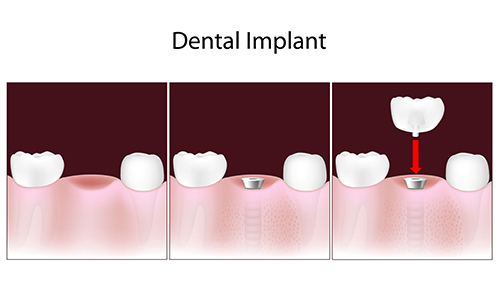



Here at Adrian M. Simm, DDS, we love helping patients transform their smiles with dental implants. However, despite the initial excitement, we also encourage our patients to use caution because jaw and oral tissues may not be adequate for dental implants immediately (read more on treatment candidacy). If this is the case, supplemental procedures can be used to provide extra help to patients to prepare for dental implant placement surgery.
When patients are missing teeth for long periods, they often stop chewing in the area where the teeth are missing. This causes the jaw muscles to atrophy or weaken. Over time, the bone in the jaw begins to deteriorate and the jawbone flattens out. This creates a sunken facial appearance and premature wrinkles around the mouth. Ultimately, it can also result in jawbone tissues that are insufficient for dental implant placement.
Much like jawbone deterioration, the gum tissues also begin to recede when teeth ae missing for long periods. This is a significant problem for bridge and denture wearers who experience discomfort, pain, and increased sensitivity in the areas where gums have receded.
Luckily for patients today, there are many great options to fix oral health issues like bone deterioration or gum recession. Two supplemental procedures that are most commonly used are gum tissue augmentation and bone grafting. Both of these treatments add proper volume to places where dense and healthy tissue is necessary.
During the actual tissue grafting procedure, a small graft of healthy gum tissue is harvested from the patient’s own mouth. This procedure can be performed during the dental implant placement or before.
After the specially harvested gum graft material is properly placed in the prepared area, the patient will be sent home to heal. The patient should rest and avoid putting any pressure on the graft area. In time, the graft will preserve the soft tissue in the dental implant area and makes the gum tissues less likely to recede after oral surgery.
To combat dangerous bone deterioration and the characteristic flattening of the jawbone after tooth loss, procedures were created to help rebuild healthy jawbone volume. Initially these procedures were designed to help patients simply wear their dentures and chew enough to eat solid foods. Early attempts at bone grafting required extensive hospital stays and painful skin grafts. The first procedures were usually ineffective, painful and often unsuccessful. However, thanks to years of thorough research, careful experimentation, and precise clinical patient trials, patients can get bone or tissue grafting right in the doctor’s office in just a few short visits.
The first step in the process is to schedule a consultation with Dr. Simm. It is necessary for the dentist to fully examine your teeth, mouth and gums in order to help you make the best decision for your optimal dental health. Gum recession is generally easier to spot right away. But jawbone deterioration often needs x-rays or cat scans to fully diagnose.
The answer to this depends largely on the individual patient’s tolerance for pain. However, during the actual procedure, general anesthesia will be administered to prevent any pain or discomfort. After the procedure, any residual pain is usually well-controlled with over the counter pain medications. On the whole, most patients experience moderate to light pain with this procedure that is no worse than a tooth extraction.
This also depends on the individual patient and the state of their health. The actual procedure only takes a few minutes. On average, most patients have healed from these procedures in three to six months.
In years past, a lack of healthy gum or jawbone tissues prevented patients from getting dental implants. Today, thanks to bone and tissue grafting, patients who were previously unable to get implants, can now take advantage of all the benefits of permanent and natural-looking tooth replacement. Call us now for a no-obligation consultation and get started on a better smile today with Adrian M. Simm, DDS.